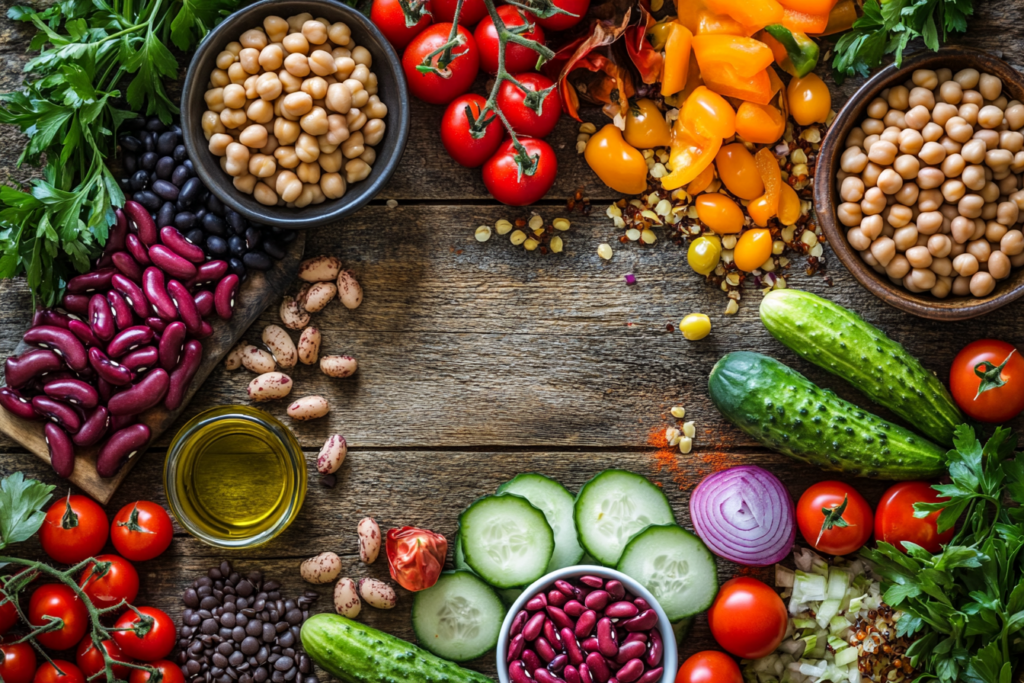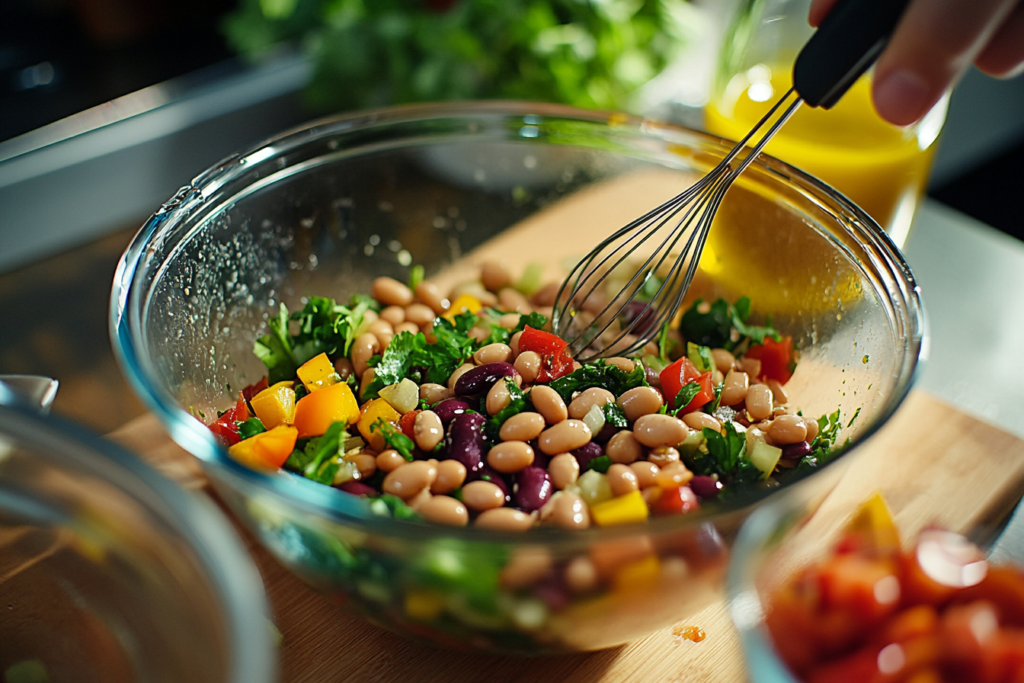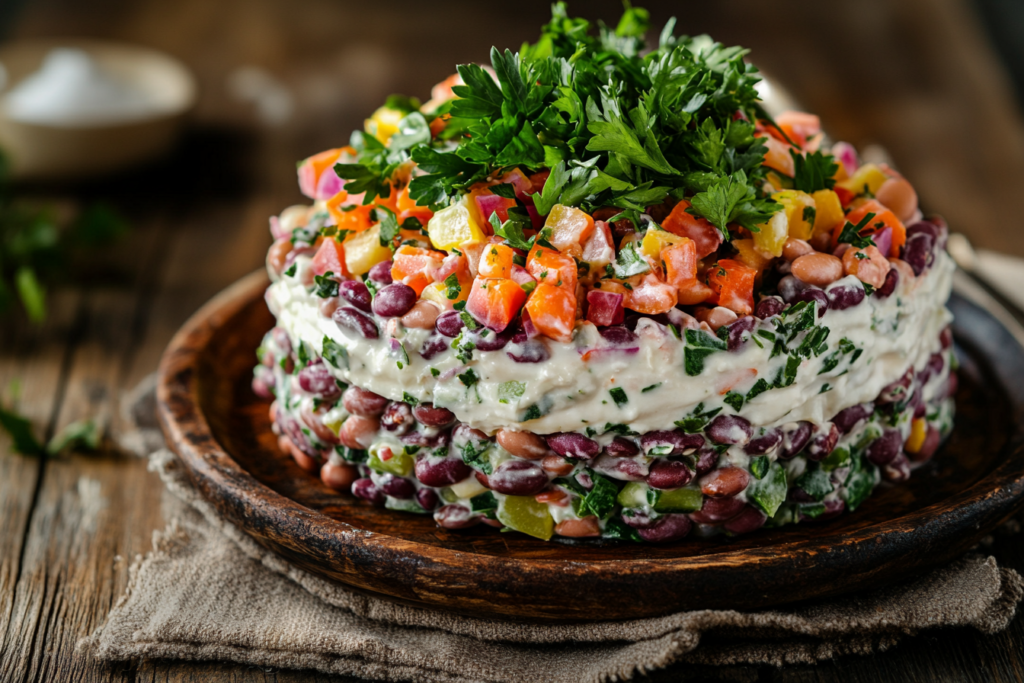Table of contents
Introduction to Dense Bean Salad
What is Dense Bean Salad?
Dense Bean Salad is a hearty, nutritious dish that combines various types of beans with fresh vegetables, herbs, and a flavorful dressing. Known for its vibrant colors, satisfying texture, and versatility, this salad is a popular choice for health-conscious individuals and food lovers alike. Packed with protein, fiber, and essential nutrients, it serves as a great side dish, a main course for vegetarians, or a quick, wholesome snack. The term “dense” in its name highlights the salad’s rich, substantial nature, making it a filling and nourishing meal option.
Brief History and Origins of the Name
The concept of bean salads dates back centuries, with beans being a staple in many ancient civilizations due to their availability and nutritional value. The term “dense bean salad” is a more modern moniker, likely coined to emphasize the abundance of ingredients and robust flavors packed into the dish. It is believed to have gained popularity as people began to experiment with combining different beans like chickpeas, kidney beans, black beans, and more to create a balanced and satisfying meal. The name reflects both the salad’s rich nutritional profile and the dense, varied textures that make it uniquely appealing. While its exact origin remains unclear, the recipe has become a beloved part of global cuisine, with countless regional variations that showcase local flavors and ingredients.
Ingredients That Make It “Dense”
Common Beans Used in the Salad
The foundation of a Dense Bean Salad lies in its variety of beans, each contributing unique textures, flavors, and nutritional benefits. Common beans used include:
- Kidney Beans: Known for their hearty texture and slightly sweet flavor.
- Chickpeas (Garbanzo Beans): Creamy and nutty, they add richness and protein.
- Black Beans: Soft and earthy, offering a contrasting color and taste.
- Cannellini Beans: Mild and tender, perfect for absorbing flavors.
- Green Beans: Crisp and fresh, providing a vibrant crunch.

These beans not only enhance the salad’s density but also ensure a balanced mix of macronutrients, including protein and fiber.
Other Key Ingredients
Beyond beans, Dense Bean Salad incorporates a range of complementary ingredients to elevate its flavor and nutritional profile:
- Fresh Vegetables: Diced tomatoes, cucumbers, bell peppers, red onions, and carrots for crunch and vitamins.
- Herbs and Spices: Parsley, cilantro, dill, or basil for aromatic freshness, and spices like cumin or paprika for depth.
- Dressings: Olive oil, lemon juice, vinegar, or mustard-based dressings to tie the flavors together.
- Extras: Nuts, seeds, or feta cheese for added texture and richness.
Each ingredient is carefully selected to add layers of flavor and ensure a vibrant, well-rounded salad.
Nutritional Density Explained
The “density” in Dense Bean Salad goes beyond its ingredients to its nutritional powerhouse status. The combination of beans and other components provides:
- Protein: Essential for muscle repair and energy, beans are a plant-based protein source ideal for vegetarians and vegans.
- Fiber: Supports digestive health and keeps you feeling full longer.
- Vitamins and Minerals: Fresh vegetables and herbs add essential nutrients like Vitamin C, potassium, and iron.
- Healthy Fats: Olive oil and nuts contribute heart-healthy fats.
This nutritional density makes Dense Bean Salad a wholesome, satisfying meal that delivers a broad spectrum of nutrients in every bite.
Historical Origins of Bean Salads
Traditional Bean Dishes from Around the World
Beans have been a cornerstone of culinary traditions across the globe, thanks to their nutritional value, affordability, and versatility. Some of the most notable traditional bean-based dishes include:
- Middle Eastern Ful Medames: A slow-cooked fava bean dish often seasoned with garlic, lemon, and olive oil.
- Latin American Frijoles Negros: Black beans simmered with spices, served as a staple side dish.
- Indian Rajma: A spiced red kidney bean curry paired with rice.
- Italian Pasta e Fagioli: A comforting soup made with beans, pasta, and aromatic herbs.
- African Koki Beans: A steamed pudding-like dish made from ground black-eyed peas.
These dishes demonstrate the cultural importance of beans, which have been used for centuries as a source of nourishment and culinary creativity.
Evolution into Dense Bean Salad
The modern concept of Dense Bean Salad has its roots in these traditional dishes but emerged as global cuisines began to intermingle. Early bean salads were likely simpler, using single types of beans mixed with basic dressings. Over time, with the growing availability of different beans and the influence of health-conscious eating, recipes became more elaborate.
The evolution into “dense” bean salad reflects a shift towards incorporating multiple types of beans, fresh vegetables, and diverse dressings to create a rich, layered dish. This transformation was driven by:
- Nutritional Awareness: Highlighting the protein, fiber, and vitamin content of beans and vegetables.
- Convenience: A salad that can be prepared quickly and served cold or at room temperature.
- Global Influences: Drawing inspiration from Mediterranean, Latin American, and Asian flavor profiles.
Dense Bean Salad is now a celebrated dish, blending the practicality and heritage of traditional bean dishes with modern dietary preferences for wholesome, plant-based meals.
How to Prepare Dense Bean Salad

Step-by-Step Preparation Guide
- Gather Ingredients:
- Beans: Use a mix of your choice, such as kidney beans, chickpeas, black beans, and cannellini beans (canned or cooked).
- Vegetables: Chop tomatoes, cucumbers, red onions, and bell peppers.
- Herbs: Finely chop parsley, cilantro, or basil.
- Dressing: Prepare a mix of olive oil, lemon juice, garlic, Dijon mustard, salt, and pepper.
- Prepare the Beans:
- If you’re using canned beans, rinse them thoroughly to eliminate excess sodium.
- If cooking beans from scratch, soak them overnight and boil until tender.
- Combine Ingredients:
- In a large bowl, mix the beans and chopped vegetables.
- Add fresh herbs for a burst of flavor.
- Make the Dressing:
- Whisk together olive oil, lemon juice, Dijon mustard, minced garlic, and your preferred spices (such as cumin or paprika) until the mixture is well emulsified.
- Mix and Chill:
- Drizzle the dressing over the salad and toss gently to evenly coat.
- Let the salad chill in the refrigerator for at least 30 minutes to allow flavors to meld.
- Serve:
- Garnish with extras like feta cheese, sunflower seeds, or avocado slices.
- Serve as a side dish or a light main course.
Key Tips for Achieving Optimal “Density”
- Use a Variety of Beans:
- Incorporate at least three different types of beans to achieve a robust texture and balanced flavor profile.
- Focus on Freshness:
- Freshly chopped vegetables and herbs enhance the overall taste and nutritional value.
- Balance the Dressing:
- The dressing should complement the beans without overpowering them. Adjust acidity and seasoning to taste.
- Chill for Better Flavor:
- Allow the salad to rest before serving to enhance the melding of flavors.
- Experiment with Add-ins:
- Consider adding roasted vegetables, nuts, or grains like quinoa for extra density and variety.
By following these steps and tips, you can create a Dense Bean Salad that is both delicious and nutritionally satisfying, perfect for any occasion.
Why the “Dense” Appeal?
Texture and Mouthfeel
The charm of Dense Bean Salad lies largely in its texture and mouthfeel. The combination of various beans offers a medley of experiences:
- Creamy Chickpeas: Provide a soft, smooth bite.
- Firm Kidney and Black Beans: Add a chewy, hearty texture.
- Crisp Vegetables: Like cucumbers and bell peppers, introduce a refreshing crunch.
- Topping Variety: Seeds, nuts, or crumbled cheese contribute additional layers of tactile satisfaction.
This interplay of textures makes every bite of the salad engaging, offering a rich and satisfying culinary experience.

Visual Appeal in Plating
Dense Bean Salad is both highly nutritious and visually appealing, making it a popular choice for casual meals and sophisticated gatherings alike. Key elements of its visual appeal include:
- Color Contrast: The combination of bright red tomatoes, fresh green herbs, yellow bell peppers, and multicolored beans creates a stunning and vibrant visual palette.
Layering: Serving the salad in transparent bowls or layering it in jars beautifully showcases the variety of textures and colors. - Garnish: A sprinkle of herbs or a drizzle of dressing adds a finishing touch that enhances its visual allure.
This vibrant presentation makes the dish as pleasing to the eyes as it is to the palate.
The Role of Ingredients in Density Perception
The “dense” quality of the salad comes from a carefully curated combination of ingredients that highlight both substance and variety:
- High Bean Content: The predominant use of beans ensures a filling and protein-rich base.
- Balanced Additions: Fresh vegetables and herbs add a light, refreshing touch while preserving the salad’s hearty character.
- Complementary Dressing: A robust, flavorful dressing binds the components together, emphasizing the salad’s cohesiveness.
- Optional Extras: Ingredients like avocado, grains, or cheese enhance the density, making the salad feel more like a complete meal.
The careful choice and balance of ingredients ensure the salad lives up to its “dense” name, delivering on flavor, nutrition, and satisfaction in every bite.
Health Comparisons: Dense Bean Salad vs. Other Salads
Nutritional Breakdown
Dense Bean Salad distinguishes itself with a superior nutritional profile, boasting high protein and fiber content primarily sourced from its bean base. Here’s how it compares:
- Dense Bean Salad:
- High in protein (from beans like chickpeas, black beans, and kidney beans).
- Rich in fiber, supporting digestion and satiety.
- Packed with vitamins and minerals from fresh vegetables and herbs.
- Contains healthy fats from olive oil or other dressings.
- Leafy Green Salads:
- Lower in protein and fiber unless supplemented with nuts, seeds, or proteins like chicken.
- High in vitamins (especially Vitamin K, Vitamin A).
- Often less filling due to a lack of complex carbohydrates.
Dense Bean Salad offers a well-balanced macronutrient profile, making it an excellent complete meal option, particularly for vegetarians and vegans.
Caloric Comparison
Dense Bean Salad may have a slightly higher calorie count than lighter green salads, but its nutrient density and ability to keep you feeling full make it a highly satisfying choice. For instance:
- Dense Bean Salad:
- Calories: ~300-400 per serving (depending on the dressing and toppings).
- High satiety due to protein and fiber.
- Leafy Green Salad (with basic dressing):
- Calories: ~150-250 per serving.
- Lower satiety unless paired with substantial add-ins like chicken or nuts.
Although higher in calories, Dense Bean Salad provides lasting energy and curbs hunger more effectively than standard green salads.
Dietary Flexibility
Dense Bean Salad is highly versatile, making it ideal for accommodating a variety of dietary needs:
- Vegetarian/Vegan-Friendly: Naturally plant-based and rich in protein.
- Gluten-Free: Beans and vegetables are naturally gluten-free, making it a safe choice for those with celiac disease or gluten sensitivities.
- Low-Sodium Options: Can be adjusted by rinsing canned beans and using minimal salt in the dressing.
- Customizable for Specific Diets: Can be tailored with additional protein (like grilled chicken) or fats (like avocado) to meet ketogenic or high-protein dietary requirements.
Dense Bean Salad stands out for its versatility, nutritional balance, and suitability for a broader range of dietary preferences compared to other salads. It combines the best of nutrition, flavor, and flexibility, making it a superior option for health-conscious eaters.
Understanding the origins of the “dense bean salad” name goes beyond its ingredients and into the art of simplicity and flavor in culinary creations. For instance, much like how a dense bean salad easy recipe ensures a perfect balance of textures and nutrition, other dishes like the baked potato with scrambled eggs recipe highlight the importance of combining hearty ingredients in innovative ways. Additionally, exploring related topics such as the branzino recipe easy cooking guide can inspire creativity in bringing together simple ingredients for exceptional results.
Frequently Asked Questions About Dense Bean Salad
Why Should You Eat a Dense Bean Salad Today?
Dense Bean Salad is a wholesome, satisfying dish that offers numerous benefits:
- Nutritional Powerhouse: Packed with protein, fiber, vitamins, and minerals, it supports overall health and keeps you energized.
- Convenience: Quick to prepare and suitable for meal prep, it fits into busy lifestyles.
- Versatility: Enjoy it as a side dish, a main course, or a snack, with endless customization options.
- Flavorful and Filling: The combination of hearty beans, crisp vegetables, and tangy dressing creates a dish that is both delicious and satiating.
Eating Dense Bean Salad is a simple yet effective way to prioritize both nutrition and taste.
What is a Dense Bean?
The term “dense bean” refers to beans that are rich in nutrients and have a substantial texture. Beans like kidney beans, chickpeas, and black beans are considered “dense” because they are:
- Nutrient-Dense: High in protein, fiber, and essential minerals like iron and magnesium.
- Calorically Dense: Provide sustained energy compared to lighter foods.
- Texture-Dense: Their firm, creamy texture contributes to the salad’s hearty feel.
Dense beans form the core of this salad, making it a filling and nutrient-packed dish.
What is the Meaning of Bean Salad?
Bean salad refers to a dish primarily composed of various types of beans, mixed with other ingredients such as vegetables, herbs, and dressings. It is:
- A versatile, globally loved recipe that adapts to regional ingredients and flavors.
- A celebration of beans as a dietary staple, valued for their nutritional benefits and culinary versatility.
- An ideal dish for vegetarians and those seeking plant-based options.
Bean salad can be served as a side or a main dish, depending on its preparation and added ingredients.
Is it Healthy to Eat Bean Salad Every Day?
Yes, eating bean salad daily can be a healthy choice, provided it is balanced and part of a varied diet. Here’s why:
- Rich in Nutrients: Beans provide protein, fiber, and essential vitamins, while vegetables add antioxidants and phytonutrients.
- Promotes Digestive Health: High fiber content supports regular digestion.
- Supports Weight Management: Its high satiety factor can help prevent overeating.
- Customizable: Adjust ingredients to avoid monotony and ensure balanced nutrient intake.
However, be mindful of portion sizes and sodium levels, especially if using canned beans. Including a variety of foods alongside bean salad ensures you get a wide range of nutrients.
Conclusion and Final Thoughts
Encouragement to Try Making Dense Bean Salad
Dense Bean Salad is more than just a recipe—it’s a versatile, nutritious, and flavorful dish that fits seamlessly into any lifestyle. Whether you’re looking for a quick meal, a healthy addition to your diet, or a crowd-pleasing side dish, this salad has something to offer. With protein-rich beans, fresh vegetables, and tangy dressings, it delivers satisfaction in every bite.
Making Dense Bean Salad at home is simple and rewarding:
- Customizable: Tailor the ingredients to your taste preferences or dietary needs.
- Budget-Friendly: Uses affordable pantry staples like beans and fresh produce.
- Meal Prep-Friendly: Prepares easily in advance and stores well, making it perfect for busy weeks.
We encourage you to give Dense Bean Salad a try today. It’s more than just a meal—it’s an opportunity to explore flavors, prioritize your health, and savor the wholesome richness of a dish that truly embodies its “dense” name.. Happy cooking!

